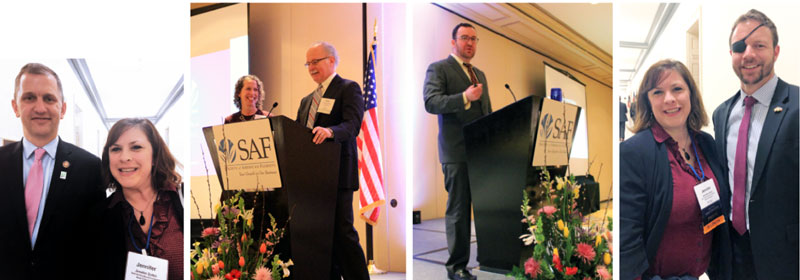4/1/2019
Do I look infected …?
Jennifer Zurko

Do I look infected …?
With Potomac Fever, I mean. If you don’t know what that is, it’s a tongue-in-cheek referral to being affected (infected?) by the power and prestige that comes with being on Capitol Hill, especially for members of Congress and powerful lobbyists with deep pockets that influence our government representatives.
I am neither one of those, so I don’t think I came home with Potomac Fever (named for the nearby Potomac River that separates D.C. from the state of Virginia). But I was a little starstruck by all of the politicians I ran into while walking the halls of the Senate and House with fellow Illinoisans representing the Society of American Florists (SAF).
For 39 years, SAF has held the annual Congressional Action Days (CAD) event where members gather in D.C. to meet with their state senators and congresspeople. (This year, CAD was on March 11-12.) It was my third year, and during the previous two, we barely saw any representatives, only meeting with their fresh-faced aides. This year, we were lucky because we ran into a good handful of legislators in their offices or just walking the halls.
As an avid follower of politics, I was fan-girling. I admit it. But it’s cool to see someone you’ve read about or seen on TV many times in person, regardless if you agree with their policies or not. Maybe not as cool as seeing your favorite athlete or musician, but for those who follow politics and truly care about what’s going on in government, it’s a neat experience.
You vote how you drink … maybe
SAF does a good job of really educating its members and preparing them to speak to their representatives. There are people who’ve been attending CAD for years and years (like Ball Hortistician and my D.C. traveling buddy Dr. Marvin Miller), but there are usually a smattering of newbies to the event, so the educational sessions are vital, especially if the issues that you’re bringing to the Hill have changed from the previous year.
SAF’s Executive VP & CEO Kate Penn opened the first day with an interesting question: “How do you advocate with the current divisive culture in our government? You take the long view.” Meaning you focus more on what will impact your business than choosing sides in the debate of the day. (More on the issues later.)
One benefit of attending these types of events in D.C. is access to a wide pool of interesting speakers and SAF always finds people who are informative and entertaining. Reid Wilson, a reporter for The Hill, spoke at the kick-off breakfast, and just like how he is when punditing on TV, he was engaging while highlighting some interesting statistics. For example, did you know that what we watch on TV and the alcoholic beverages of our choice show how we vote? On a scale of Democrat and Republican, and voter turnout, you can see where you fall depending on what you drink. Obviously, not an exact science, but everyone in the room got a kick out of seeing if their drinking habits matched their voting record. (Mine was only half correct.)
Really, the take-home message Reid focused on is the division in politics today and the three main factors at play: demographics, the generation gap and the GOP’s geographical map. There’s a large divide between urban and rural areas in the party they support, with rural Americans voting for Republicans 2 to 1. There are more people moving to urban areas, leaving those who’ve stayed (or are stuck) feeling discounted and alienated.
There’s also a large gap with regard to support for the current administration; people who identify as Republican and white men have positive numbers, whereas every other demographic—from minorities to Independent voters, were in the negative. Reid also had data from Gallup showing the gaps in institutions that people trust, with the military very high and Congress very low.
As the divides continue to widen, Reid speculated that this leaves the door open for future “outsider candidates,” as Americans have shown that they lean more toward voting for change and away from politicians they view as the “old establishment.”
The issues
We were tasked with bringing four issues to the Hill. The first, and one that’s been a regular ask, is immigration reform—more specifically, opposition to a mandatory, standalone E-verify system and support for a comprehensive bill that includes a guestworker program.
The second was opposition to the Raise the Wage Act that would raise the minimum wage to $15 across the country in a six-year period. The argument is that the minimum wage debate should remain at the state and municipal levels in order to better serve specific economic areas. A minimum wage of $15 may make sense for urban areas that have a high cost of living, but not for businesses in rural areas. For many retail florists and wholesalers, paying the guy who sweeps the floor or sleeves plants $15 an hour may not be palatable, especially for the office manager who’s already been paid $15 an hour for the last few years.
As you might guess, these two issues are divided on party lines—support for one, opposition for the other—and you can guess which party. But, regardless, the people we met with were attentive and engaging.
The last two are really in one category—appropriations, meaning money in the budget and can we have a little …? When I tell you that we asked for $1.5 million, you may stop and think that’s a lot to ask, but I said “a little” because in the grand scheme of the federal budget and what other organizations ask for, ours was small potatoes. (Or flowers, in this case.)
SAF members wanted to make sure that $1 million would still be available for the Floriculture & Nursery Research Initiative (FNRI), which helps fund the research conducted by scientists and universities through the American Floral Endowment on studies that range from post-harvest longevity to disease and pest management that help growers grow and retailers sell higher-quality plants.
We also asked that $500,000 continue to go toward funding the Floriculture Crops Summary, which is the annual survey the USDA has been conducting through the National Agricultural Statistics Service. Since 1956, the survey has been the only source of data for the specialty crops sector and taking it away (like they did in 2016 and 2017) leaves a gaping hole of information for growers and retailers. When you tell congressional aides that the Crops Summary data is like their bosses’ polling data, they get what we mean.
If all of this sounds intriguing, and you’re a supplier/grower/retailer for the cut flower market, save the date to attend CAD next year, March 9-10, 2020.
 Left photo: The Illinois delegation meeting with Senator Dick Durbin’s aide Kevin Lefeber.
Left photo: The Illinois delegation meeting with Senator Dick Durbin’s aide Kevin Lefeber.
Right photo: From left to right, Congressman Bill Foster (D-IL), Anna Ball—Ball Horticultural Company, Ed Cronin—FTD, and Dr. Marvin Miller—Ball Horticultural Company.

1. After meeting with one of his aides, we ran into new Congressman Sean Casten (D-IL)—who also happens to be MY congressman—coming out of his office.
2. SAF’s COO Drew Gruenburg is retiring at the end of this year, so CEO Kate Penn honored him with a photo of the Capitol Building and a few kind words. She joked that because Drew avoids having his photo taken, she couldn’t find one to put in a frame.
3. Reid Wilson, national correspondent for The Hill, speaks to the CAD participants about the divisions in Washington and the country as a whole.
4. Congressman Dan Crenshaw (R-TX) was so gracious to stop, shake my hand and pose for a picture. He’s a freshman congressman, a former Navy SEAL, lost his eye while serving in Afghanistan and roasted Pete Davidson on SNL.